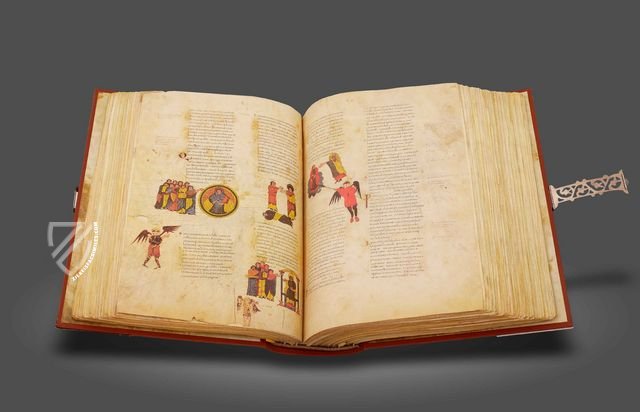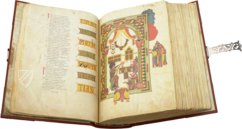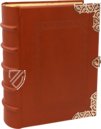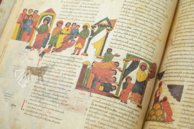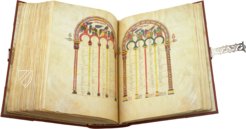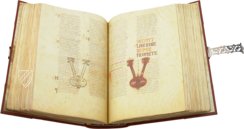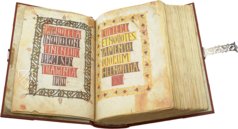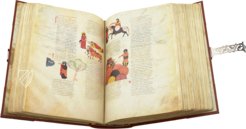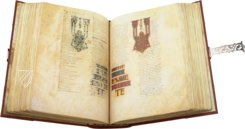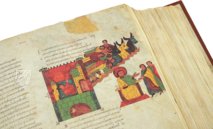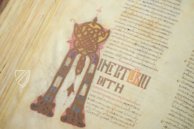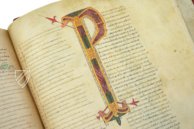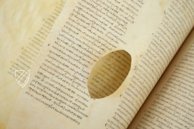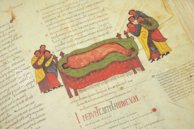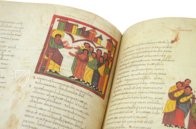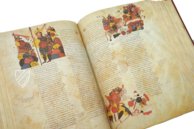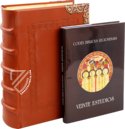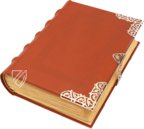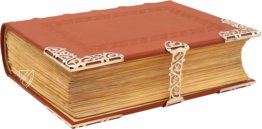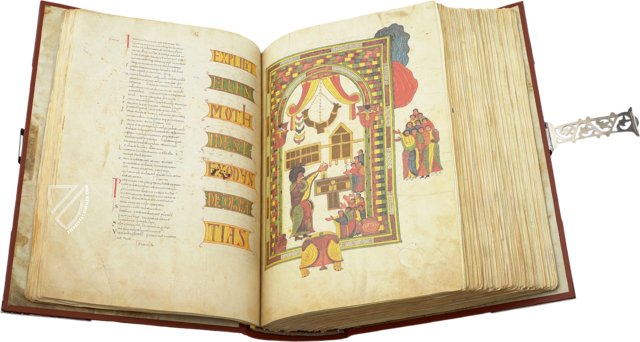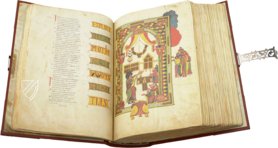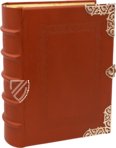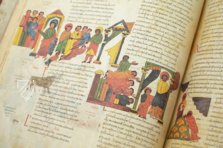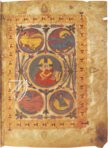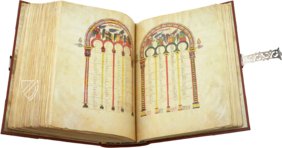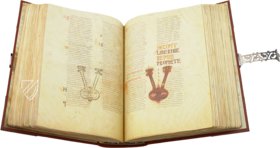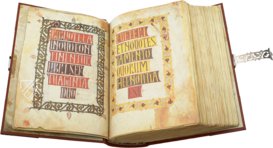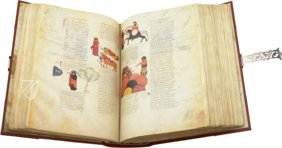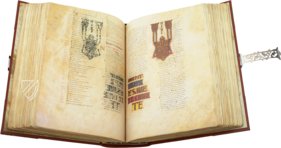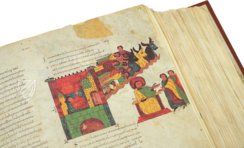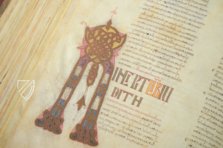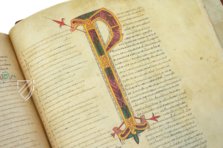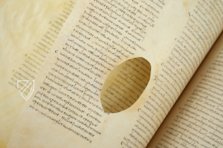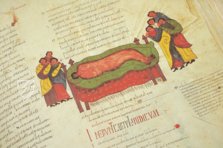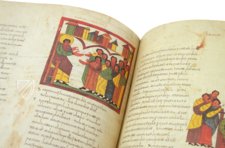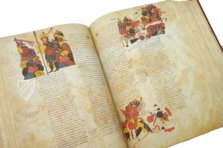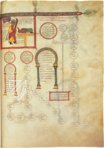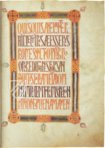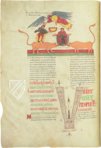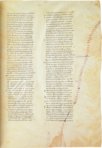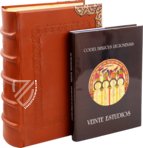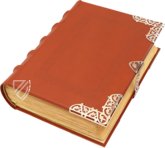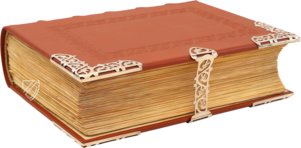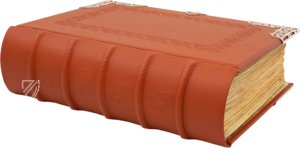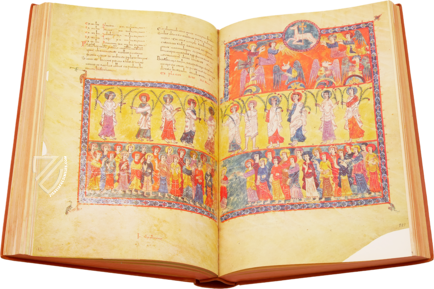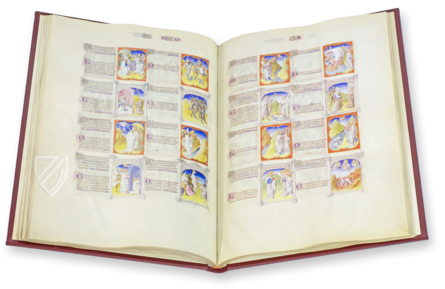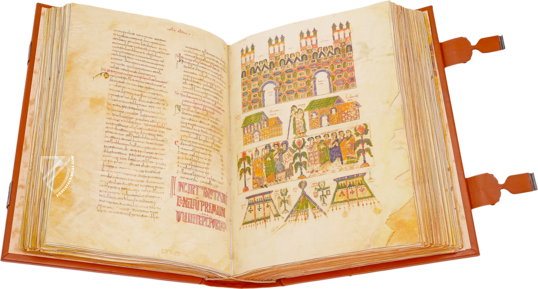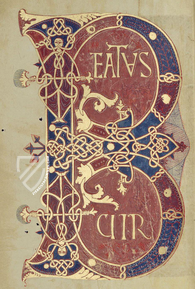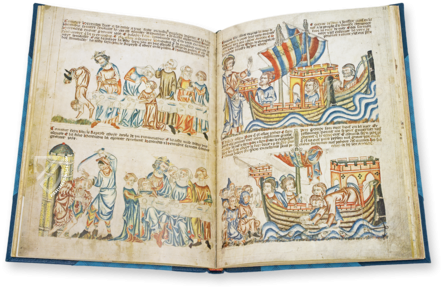Visigothic-Mozarabic Bible of St. Isidore
(over 10,000€)
A truly special early Spanish manuscript, significant for its age, rarity, artistic refinement, and as a source on life in 10th century Spain: the Visigothic-Mozarabic Bible of St. Isidore. The exact date and location of its completion, as well as the scribe and miniaturist responsible for it, are all well documented in the manuscript’s colophon, making it additionally unusual and valuable. The monastery where it was created mysteriously disappeared not long after its creation in 960, and the manuscript made its way to its current repository, the monastery of San Isidoro de León, under similarly obscure circumstances. The masterfully executed script is adorned with an incredible hybrid of early medieval illumination and features marginal notes in Latin and Arabic. This combination of factors makes the thousand-year-old manuscript a unique artifact that is highly coveted by university researchers and museum curators around the world.
Visigothic-Mozarabic Bible of St. Isidore
A Spanish Bible so old, the monastery where it was made disappeared over one thousand years ago: the Visigothic-Mozarabic Bible of St. Isidore, also known as the León Bible of 960 or Codex Biblicus Legionensis. We do not know under what circumstances the Valeránica Monastery was wiped out, perhaps in a Moorish raid, nor do we know under what circumstances the codex came to its current residence, the monastery of San Isidoro de León, although King Ferdinand I of Leon (ca. 1015–65) and his wife Sancha are hypothesized as donors. It is one of the rarest manuscripts, coveted by university researchers and museum curators across the world, and is significant for a number of reasons. Uncommon for a manuscript of this period, the exact date of its completion is recorded in a colophon: June 19th, 960. Two men, a calligrapher named Sancho and a miniaturist named Florencio are given credit for this magnificent work. Although we know nothing more of the former, the Master Florencio was originally from Moorish southern Spain before coming north and has at least six codices attributed to him while other documents indicate that he was a notary for the counts of Castile. This incredible manuscript is a priceless specimen of the Christian realms of the Iberian Peninsula from a time when they were under siege by the forces of Al-Andalus (Moorish Spain) and is distinguished from among the hybrid Visigothic-Mozarabic works to survive to the present.
A Wonderful Artistic Hybrid
The Visigoths were a Germanic people who dominated the Iberian Peninsula from their invasion in 415 until the destruction of their kingdom in the course of the Moorish invasion in 711, reducing them to a series of rump states in the mountainous north of what is modern Spain. The Visigothic artistic style, the temporal and aesthetic contemporary of the Insular and Carolingian styles of illumination, is similarly characterized by highly refined calligraphy, striking colors, and figures with large eyes and clearly gesturing hands. Developed among Christians living in Al-Andalus who adopted some of the conquerors’ customs without embracing their religion, Mozarabic art is itself a hybrid of Islamic and Christian art. Its influences appear in the miniatures, as do those from the more far flung Islamic and Sassanid artistic traditions. Later driven north by the increasingly difficulty of life under Moorish rule, these Christians brought the artistic traditions of Islam with them. The manuscript additionally bears clear influences from Insular Illumination, particularly in the Celtic-knot initials. 100+ episodes from the Bible are illustrated in the text, in addition to numerous embellishing features. The miniatures are valued both for the quality of their artistry and for their detailed depictions of life in 10th century Spain: churches, palaces, household goods, civil and military costume, armor, even bull-fighting from horseback are all depicted. Finally, the text features numerous marginal notes in both Latin and Arabic. Thus, the manuscript is an incomparable source for paleographers and historians of art and culture.
Codicology
- Alternative Titles
- Biblia Visigótica Mozárabe de San Isidoro
Westgotisch-mozarabische Bibel des Heiligen Isidor von Sevilla
León Bible of 960
Bibel von Leon
Bibel von León
Bible of León
Codex Biblicus Legionensis
Codex Gothicus Legionensis
Biblia de Leon
Biblia Visigótica Mozárabe de San Isidoro
Biblia Primera
Bible of St. Isidore - Size / Format
- 1026 pages / 48.5 × 34.5 cm
- Origin
- Spain
- Date
- June 19, 960
- Epochs
- Style
- Genre
- Script
- Visigothic Minuscule
- Illustrations
- 334 miniatures, 80 of them in the Old Testament; 17 decorative canon tables and a richly decorated colophon; numerous large decorative initials
- Content
- Complete Bible including canon tables, genealogical trees, colophon and commentaries
- Artist / School
- Florencio (illuminator)
Sancho (scribe) - Previous Owners
- Monastery of St. Isidore's in León
Ferdinand I
Visigothic-Mozarabic Bible of St. Isidore
Christ in Majesty
Christ sits enthroned, his right hand is extended in the sign of benediction while his left holds a book. A golden crossed-halo adorns his head and he is dressed in bright red garments – a color rarely associated with Christ outside of the Spanish tradition of Beatus manuscripts. The so-called Maiestas Domini is one of the most popular images in Western Christian art and is presented here flanked by the Evangelist Symbols.
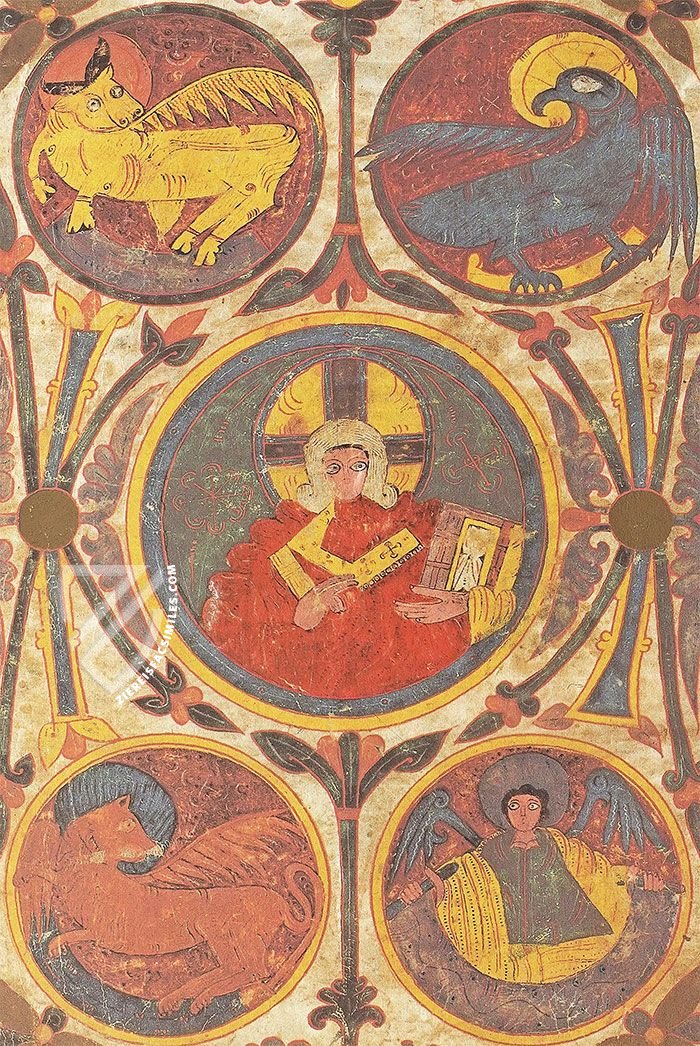
Visigothic-Mozarabic Bible of St. Isidore
Incipit Page: Book of Genesis
This splendid incipit page is strongly influenced by contemporary Beatus manuscripts and is a wonderful hybrid of styles from early medieval illumination. Furthermore, marginal notes have been written in both Latin and Arabic. The highly refined calligraphy and striking color palate are typical of Visigothic art, while the intricate interlace patterns imitate Insular illumination.
Gold leaf has been liberally employed and is further highlighted by outlining it with a bright red-orange colors for the first few words of the Book of Genesis. The head and tail of the initial are magnificently adorned with leafy tendrils originating from the Mozarabic tradition and created with a complexity that rivals the work of Carolingian illuminators.
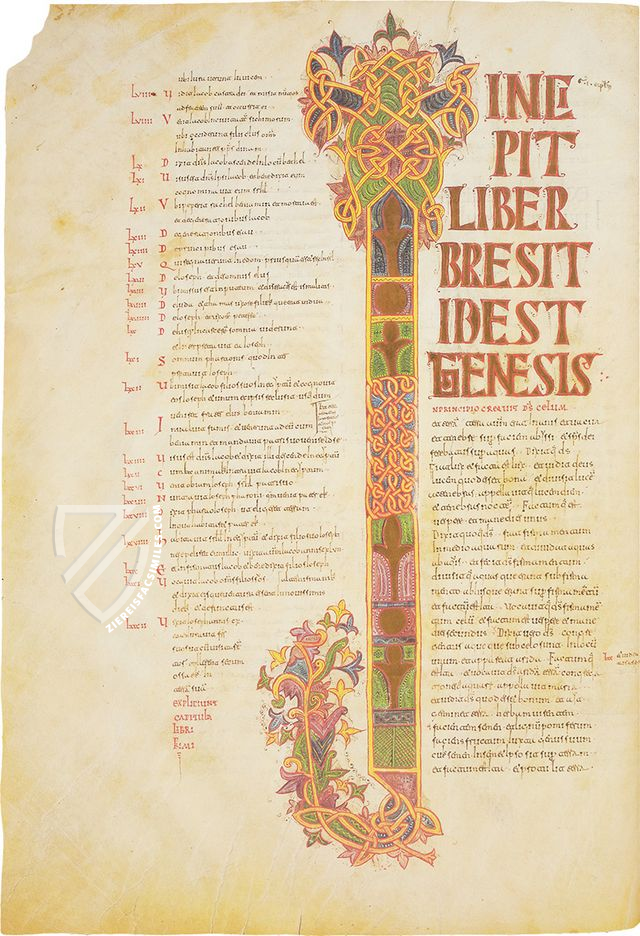
#1 Biblia Visigótica Mozárabe de San Isidoro
Language: Spanish
(over 10,000€)
- Treatises / Secular Books
- Apocalypses / Beatus
- Astronomy / Astrology
- Bestiaries
- Bibles / Gospels
- Chronicles / History / Law
- Geography / Maps
- Saints' Lives
- Islam / Oriental
- Judaism / Hebrew
- Single Leaf Collections
- Leonardo da Vinci
- Literature / Poetry
- Liturgical Manuscripts
- Medicine / Botany / Alchemy
- Music
- Mythology / Prophecies
- Psalters
- Other Religious Books
- Games / Hunting
- Private Devotion Books
- Other Genres
- Afghanistan
- Armenia
- Austria
- Belgium
- Belize
- Bosnia and Herzegovina
- China
- Colombia
- Costa Rica
- Croatia
- Cyprus
- Czech Republic
- Denmark
- Egypt
- El Salvador
- Ethiopia
- France
- Germany
- Greece
- Guatemala
- Honduras
- Hungary
- India
- Iran
- Iraq
- Israel
- Italy
- Japan
- Jordan
- Kazakhstan
- Kyrgyzstan
- Lebanon
- Liechtenstein
- Luxembourg
- Mexico
- Morocco
- Netherlands
- Palestine
- Panama
- Peru
- Poland
- Portugal
- Romania
- Russia
- Serbia
- Spain
- Sri Lanka
- Sweden
- Switzerland
- Syria
- Tajikistan
- Turkey
- Turkmenistan
- Ukraine
- United Kingdom
- United States
- Uzbekistan
- Vatican City
- A. Oosthoek, van Holkema & Warendorf
- Aboca Museum
- Ajuntament de Valencia
- Akademie Verlag
- Akademische Druck- u. Verlagsanstalt (ADEVA)
- Aldo Ausilio Editore - Bottega d’Erasmo
- Alecto Historical Editions
- Alkuin Verlag
- Almqvist & Wiksell
- Amilcare Pizzi
- Andreas & Andreas Verlagsbuchhandlung
- Archa 90
- Archiv Verlag
- Archivi Edizioni
- Arnold Verlag
- ARS
- Ars Magna
- ArtCodex
- AyN Ediciones
- Azimuth Editions
- Badenia Verlag
- Bärenreiter-Verlag
- Belser Verlag
- Belser Verlag / WK Wertkontor
- Benziger Verlag
- Bernardinum Wydawnictwo
- BiblioGemma
- Biblioteca Apostolica Vaticana (Vaticanstadt, Vaticanstadt)
- Bibliotheca Palatina Faksimile Verlag
- Bibliotheca Rara
- Boydell & Brewer
- Bramante Edizioni
- Bredius Genootschap
- Brepols Publishers
- British Library
- C. Weckesser
- Caixa Catalunya
- Canesi
- CAPSA, Ars Scriptoria
- Caratzas Brothers, Publishers
- Carus Verlag
- Casamassima Libri
- Centrum Cartographie Verlag GmbH
- Chavane Verlag
- Christian Brandstätter Verlag
- Circulo Cientifico
- Club Bibliófilo Versol
- Club du Livre
- CM Editores
- Collegium Graphicum
- Collezione Apocrifa Da Vinci
- Comissão Nacional para as Comemorações dos Descobrimentos Portugueses
- Coron Verlag
- Corvina
- CTHS
- D. S. Brewer
- Damon
- De Agostini/UTET
- De Nederlandsche Boekhandel
- De Schutter
- Deuschle & Stemmle
- Deutscher Verlag für Kunstwissenschaft
- DIAMM
- Droz
- E. Schreiber Graphische Kunstanstalten
- Ediciones Boreal
- Ediciones Grial
- Ediclube
- Edições Inapa
- Edilan
- Editalia
- Edition Deuschle
- Edition Georg Popp
- Edition Leipzig
- Edition Libri Illustri
- Editiones Reales Sitios S. L.
- Éditions de l'Oiseau Lyre
- Editions Medicina Rara
- Editorial Casariego
- Editorial Mintzoa
- Editrice Antenore
- Editrice Velar
- Edizioni Edison
- Egeria, S.L.
- Eikon Editores
- Electa
- Emery Walker Limited
- Enciclopèdia Catalana
- Eos-Verlag
- Ephesus Publishing
- Ernst Battenberg
- Eugrammia Press
- Extraordinary Editions
- Fackelverlag
- Facsimila Art & Edition
- Facsimile Editions Ltd.
- Facsimilia Art & Edition Ebert KG
- Faksimile Verlag
- Feuermann Verlag
- Folger Shakespeare Library
- Franco Cosimo Panini Editore
- Friedrich Wittig Verlag
- Fundación Hullera Vasco-Leonesa
- G. Braziller
- Gabriele Mazzotta Editore
- Gebr. Mann Verlag
- Gesellschaft für graphische Industrie
- Getty Research Institute
- Giovanni Domenico de Rossi
- Giunti Editore
- Graffiti
- Grafica European Center of Fine Arts
- Guido Pressler
- Guillermo Blazquez
- Gustav Kiepenheuer
- H. N. Abrams
- Harrassowitz
- Harvard University Press
- Helikon
- Hendrickson Publishers
- Henning Oppermann
- Herder Verlag
- Hes & De Graaf Publishers
- Hoepli
- Holbein-Verlag
- Houghton Library
- Hugo Schmidt Verlag
- Idion Verlag
- Il Bulino, edizioni d'arte
- ILte
- Imago
- Insel Verlag
- Insel-Verlag Anton Kippenberger
- Instituto de Estudios Altoaragoneses
- Instituto Nacional de Antropología e Historia
- Introligatornia Budnik Jerzy
- Istituto dell'Enciclopedia Italiana - Treccani
- Istituto Ellenico di Studi Bizantini e Postbizantini
- Istituto Geografico De Agostini
- Istituto Poligrafico e Zecca dello Stato
- Italarte Art Establishments
- Jan Thorbecke Verlag
- Johnson Reprint Corporation
- Josef Stocker
- Josef Stocker-Schmid
- Jugoslavija
- Karl W. Hiersemann
- Kasper Straube
- Kaydeda Ediciones
- Kindler Verlag / Coron Verlag
- Kodansha International Ltd.
- Konrad Kölbl Verlag
- Kurt Wolff Verlag
- La Liberia dello Stato
- La Linea Editrice
- La Meta Editore
- Lambert Schneider
- Landeskreditbank Baden-Württemberg
- Leo S. Olschki
- Les Incunables
- Liber Artis
- Library of Congress
- Libreria Musicale Italiana
- Lichtdruck
- Lito Immagine Editore
- Lumen Artis
- Lund Humphries
- M. Moleiro Editor
- Maison des Sciences de l'homme et de la société de Poitiers
- Manuscriptum
- Martinus Nijhoff
- Maruzen-Yushodo Co. Ltd.
- MASA
- Massada Publishers
- McGraw-Hill
- Metropolitan Museum of Art
- Militos
- Millennium Liber
- Müller & Schindler
- Nahar - Stavit
- Nahar and Steimatzky
- National Library of Wales
- Neri Pozza
- Nova Charta
- Oceanum Verlag
- Odeon
- Orbis Mediaevalis
- Orbis Pictus
- Österreichische Staatsdruckerei
- Oxford University Press
- Pageant Books
- Parzellers Buchverlag
- Patrimonio Ediciones
- Pattloch Verlag
- PIAF
- Pieper Verlag
- Plon-Nourrit et cie
- Poligrafiche Bolis
- Presses Universitaires de Strasbourg
- Prestel Verlag
- Princeton University Press
- Prisma Verlag
- Priuli & Verlucca, editori
- Pro Sport Verlag
- Propyläen Verlag
- Pytheas Books
- Quaternio Verlag Luzern
- Reales Sitios
- Recht-Verlag
- Reichert Verlag
- Reichsdruckerei
- Reprint Verlag
- Riehn & Reusch
- Roberto Vattori Editore
- Rosenkilde and Bagger
- Roxburghe Club
- Salerno Editrice
- Saltellus Press
- Sandoz
- Sarajevo Svjetlost
- Schöck ArtPrint Kft.
- Schulsinger Brothers
- Scolar Press
- Scrinium
- Scripta Maneant
- Scriptorium
- Shazar
- Siloé, arte y bibliofilia
- SISMEL - Edizioni del Galluzzo
- Sociedad Mexicana de Antropología
- Société des Bibliophiles & Iconophiles de Belgique
- Soncin Publishing
- Sorli Ediciones
- Stainer and Bell
- Studer
- Styria Verlag
- Sumptibus Pragopress
- Szegedi Tudomànyegyetem
- Taberna Libraria
- Tarshish Books
- Taschen
- Tempus Libri
- Testimonio Compañía Editorial
- Thames and Hudson
- The Clear Vue Publishing Partnership Limited
- The Facsimile Codex
- The Folio Society
- The Marquess of Normanby
- The Richard III and Yorkist History Trust
- Tip.Le.Co
- TouchArt
- TREC Publishing House
- TRI Publishing Co.
- Trident Editore
- Tuliba Collection
- Typis Regiae Officinae Polygraphicae
- Union Verlag Berlin
- Universidad de Granada
- University of California Press
- University of Chicago Press
- Urs Graf
- Vallecchi
- Van Wijnen
- VCH, Acta Humaniora
- VDI Verlag
- VEB Deutscher Verlag für Musik
- Verlag Anton Pustet / Andreas Verlag
- Verlag Bibliophile Drucke Josef Stocker
- Verlag der Münchner Drucke
- Verlag für Regionalgeschichte
- Verlag Styria
- Vicent Garcia Editores
- W. Turnowski Ltd.
- W. Turnowsky
- Waanders Printers
- Wiener Mechitharisten-Congregation (Wien, Österreich)
- Wissenschaftliche Buchgesellschaft
- Wissenschaftliche Verlagsgesellschaft
- Wydawnictwo Dolnoslaskie
- Xuntanza Editorial
- Zakład Narodowy
- Zollikofer AG

